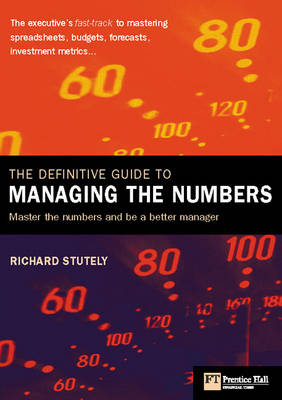
The Definitive Guide to Managing the Numbers
FT Press (Verlag)
978-0-273-66103-0 (ISBN)
- Titel erscheint in neuer Auflage
- Artikel merken
"The Definitive Guide to Managing the Numbers "takes you step-by-step through the whole process of "doing the numbers," assuming no specialised prior knowledge. It explains how to use standard PC software to simplify the process and cross-check your results. It reveals shortcuts and tricks that will help make you a financial wizard. You will not only be able to produce an outstanding set of financials, you will also have a much clearer understanding of what they mean and how to use them to be a more effective manager. Moreover, you won't fear dealing with people who make numbers their business: instead talk their language, win the arguments, and never be intimidated by a finance meeting ever again. Daunted by financials? This is the book for you.
Richard has been managing the numbers throughout his career, which has spanned banking and finance, government, and business in Europe, North America, the Middle East and Asia-Pacific. As a manager at all levels and a director, he has produced, managed and analyzed hundreds of project plans, departmental and enterprise budgets, cash flow statements, income accounts and balance sheets. Richard received a solid grounding in finance and accounting with NatWest and went on to become an investment analyst and chief economist with top investment banks. He was formerly a member of the London International Stock Exchange and has worked at HM Treasury, the British Finance Ministry. As executive vice president of a multinational software company, Richard developed and directly managed financial reporting and analysis for subsidiaries in several countries. In addition, Richard developed one of the world's first PC spreadsheet applications. Richard has written several books including the international bestseller The Definitive Business Plan. When Richard is not writing books or managing a multinational software company, he runs seminars and lectures to MBA students and corporate audiences.
Chapter 1. The Journey Starts Here Part 1. Attaining mastery over numbers First, I will help you suit up with the weapons and armour needed to do battle. Chapter 2 Where Managers and Numbers Meet reviews this magical kingdom and starts to show you how to use the numbers to your advantage. Chapter 3 How The Finance Director Thinks looks at mindset of the professionals with whom you will be dealing. Chapter 4 The Financial Wizard's Toolbox investigates the tools you use to hammer the numbers - primarily spreadsheets. Chapter 5 Taming Numbers - provides a refresher about some numerical techniques. Patr 2. Managing money Second, now you are forearmed, we can move on to income and expenditure. I will show you how to dominate every penny that comes into and flows out of your coffers. Chapter 6 Keeping Score reviews the rudiments of bookkeeping, with a special note on matters such as looking after the petty cash and dealing with expenses claims. Chapter 7 How to Analyze Figures in the Fourth Dimension introduces ways of looking at how numbers have changed over time - and how this highlights what is happening to the business. Chapter 8 How to Forecast Anything explains how to form a realistic view about potential future trends - with particular attention on forecasting sales. Chapter 9 Getting to Gross Profit touches on broader aspects of sales revenue. Chapter 10 Creating Capital considers the special factors surrounding capital spending (often huge outlays where there is longer-term benefit and perhaps short-term pain). Chapter 11 Controlling Costs looks at other spending - the cash that seems to go up in smoke instantly when you pay telephone bills, rent, and so on. Part 3. Doing the numbers Now you have a good understanding of number crunching techniques, as well as hands-on experience dealing with the figures that finance your business. You are now ready to pull them together for some serious business reporting, analysis and decision-making, and control. Chapter 12 Brilliant Budgets reviews the budgeting process. Chapter 13 Perfect Projects reveals the secrets of killer project management - feasibility studies, planning, decision and control. Good stuff applicable everywhere in surprising ways. Chapter 14 Producing a Profit investigates income statements, known in the UK and elsewhere as profit and loss accounts. These are just budgets or project plans restated. Chapter 15 Building a Balance Sheet looks at balance sheets - misunderstood (to say the least) medical reports about of the health of any business. Chapter 16 Controlling Cash Flow considers sources and uses of funds - highlighting ways of re-casting the figures already dealt with to give you better management control over cash. Part 4. Managing better By now, you are all set for success. Chapter 17 Seeing the Big Picture looks at how you pull all the components together - and how individual figures relate to and mesh with those of the enterprise as a whole. Chapter 18 Making Better Financial Decisions aim to help you do just that - covering questions such as how profitable is my business, which product lines are most profitable, and which business units are most vulnerable. Chapter 19 Managing the Numbers will let you manage financials better on a daily basis - with shortcuts to incisive analysis, tips for handling financial meetings, presentations and beanies, and so on. Chapter 20. When Things Go Wrong deals with the inevitable - what to do when things go wrong; things such as cost overruns, economic recessions, unexpectedly low income, interest and exchange rate surprises, funding cuts, too much money; budget under-runs and overruns, projects out of control, moved goal posts, forecasts that have to be revised, and asking for more.
| Erscheint lt. Verlag | 7.8.2003 |
|---|---|
| Sprache | englisch |
| Maße | 170 x 242 mm |
| Gewicht | 740 g |
| Themenwelt | Wirtschaft ► Betriebswirtschaft / Management ► Finanzierung |
| Wirtschaft ► Betriebswirtschaft / Management ► Rechnungswesen / Bilanzen | |
| ISBN-10 | 0-273-66103-5 / 0273661035 |
| ISBN-13 | 978-0-273-66103-0 / 9780273661030 |
| Zustand | Neuware |
| Haben Sie eine Frage zum Produkt? |
aus dem Bereich



